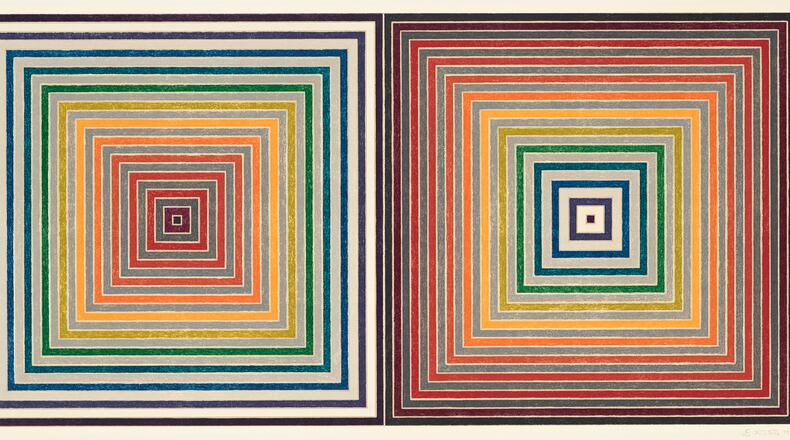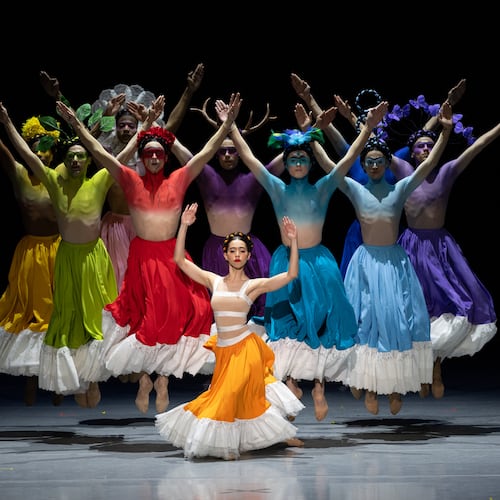Artist Sol LeWitt is responsible for two familiar Atlanta monuments: the large mural in the High Museum of Art’s Robinson Atrium and the once-controversial “54 Columns” sculpture in Old Fourth Ward that is about to undergo a facelift.
His art often consists of repeated geometric forms, lines and grids. “The idea becomes a machine that makes art,” he wrote in a famous 1967 essay that privileged concept in artistic practice. It’s a far cry from the gestural abstraction and vaporous color that dominated the preceding generation of postwar Western art and is like a thesis statement for conceptual art of the 1960s and ‘70s.
Despite its formulaic nature, the grid occupies a surprisingly large place in art history of the past century, preceding LeWitt’s conceptual work by decades. “Off the Grid,” on view through Sept. 4, shows off the potential of these multivalent signifiers. LeWitt’s etchings are a prime example. He deconstructs the seeming order of systems rather than champions it.
In 1979, critic Rosalind Krauss, a great apologist for LeWitt, published an essay that traced 20th-century artists’ use of the grid back to 19th-century optical theory. She builds a dense critical account that presents it, among other things, as a motif capable of both a scientific and spiritual meaning.
The show’s clever title suggests that it is both “of” and “off” Krauss’ conception of the grid. It also points to the curators’ effort to do what Krauss did not: to extend the grid’s ubiquity beyond the canon of Western art.
Credit: Courtesy of the Estate of Agatha Bennett/Artists Rights Society (ARS), New York.
Credit: Courtesy of the Estate of Agatha Bennett/Artists Rights Society (ARS), New York.
Along with LeWitt, “Off the Grid” opens with selections from Detroit-born photographer Harry Callahan and Gee’s Bend quilter Agatha Bennett. References to the American South show up throughout the exhibit. One of Callahan’s photographs features Atlanta architecture, showing a matrix of windows. The celebration of Gee’s Bend quilters is nothing new, but Alabama-based Bennett’s quilt acts as a reminder of the grid’s presence beyond its most expected places.
A 16th-century drawing by Baldassare Peruzzi and an example of chronophotography by Eadweard Muybridge introduce the section “Systems.” Muybridge is an oft-cited influence on 20th-century art, especially LeWitt. Yet this section merely hints at this relationship, calling for more historical development.
Made of tiny dots from hole-punched paper, “Untitled #69″ (1974) by Howardena Pindell reads like a miniature carpet in its intricacy. Pindell, who had her first big solo show at Spelman College, references circles placed on products in stores during her childhood that indicated white-only products. The piled-up dots suggest years of accumulated pain and oppression.
Photographs are prominent in the next section, “Grids Among Us.” Urban details, such Walker Evans’ “New York City Sewer Grate” (1929), showcase the grid’s presence in built environments. The city manifests itself differently in Alabama-born Ronald Lockett’s “Untitled” from the Oklahoma series (ca. 1996). Reacting to the Oklahoma City bombing, Lockett utilizes cast-off materials to make an assemblage sculpture influenced by quilting — a deft curatorial moment that ties back to Bennett’s work.
A midcentury-style bookcase appears in Atlanta artist photographer Sheila Pree Bright’s “Untitled 28.” From Bright’s Suburbia series (2007), the interior view of a Black home was created to complicate stereotypes of African American domesticity. The careful layout of the bookshelf nicely contrasts the jumbled interior of its neighbor, Tennessean William Eggleston’s photograph “Untitled (Freezer).” The packed freezer overflows with frosted-over 1970s fare such as “Tasty Taters” and beef pie. The pairing of Bright and Eggleston has many layers, with race and class at the forefront. Aesthetically, the duo foreshadows the curator’s next section, devoted to “Containment and Expansion.”
One of Krauss’ motifs in her essay was the grid’s ability to appear either boundless or bounded — or, more potently, both.
Frank Jones’ “Spider King Devil House” (1965-66) continues the visionary thread started with Murray’s “written” work. Jones shows a drawing of spirit beings contained in a house pictured in a cutaway view reminiscent of medieval art. Jones made this work from scrap materials while imprisoned, and the clearly delineated architecture surrounding his ghostly figures suggests the confines of the bounded grid in literal and figurative ways. Op artist Victor Vasarely and minimalist Frank Stella use color theory and geometric form to create two-dimensional works that appear to oscillate and expand off the page.
Credit: Romare Bearden Foundation/VAGA at Artists Rights Society (ARS), NY.
Credit: Romare Bearden Foundation/VAGA at Artists Rights Society (ARS), NY.
Bringing a conclusion to “Off the Grid” is “Sum of Its Parts.” Devoted to art that forms physical grids, it includes two works by Romare Bearden that give insight into his planning and production for a now-demolished mural dedicated to the Rev. Martin Luther King Jr. for Atlanta’s Kutz Building.
Among the most recent work, Benjamin Rollins Caldwell’s “Lightbox Armchair” (2014–2015) brings many threads together: The Southern designer uses slides showing works from the High’s decorative-arts collection. It’s a self-referential move that reminds the viewer that this is an in-house exhibition showcasing the many ways a museum’s collection might be configured.
Credit: Courtesy of Benjamin Rollins Caldwell and the High Museum of Art
Credit: Courtesy of Benjamin Rollins Caldwell and the High Museum of Art
The curators’ thematic approach highlights cross-cultural connections, giving needed attention to women, artists of color and art from the American South.
Looking back to the exhibition’s influences, including Krauss’ essay, this show is a reminder that contributions of her generation can be thoughtfully incorporated into a better art history.
VISUAL ART REVIEW
“Off the Grid”
Through Sept. 4. $16.50, ages 6 and older; ages 5 and younger free. High Museum of Art, 1280 Peachtree St. NE, Atlanta. 404-733-4444, high.org.
Credit: ArtsATL
Credit: ArtsATL
MEET OUR PARTNER
ArtsATL (www.artsatl.org), is a nonprofit organization that plays a critical role in educating and informing audiences about metro Atlanta’s arts and culture. Founded in 2009, ArtsATL’s goal is to help build a sustainable arts community contributing to the economic and cultural health of the city.
If you have any questions about this partnership or others, please contact Senior Manager of Partnerships Nicole Williams at nicole.williams@ajc.com.
About the Author
Keep Reading
The Latest
Featured





